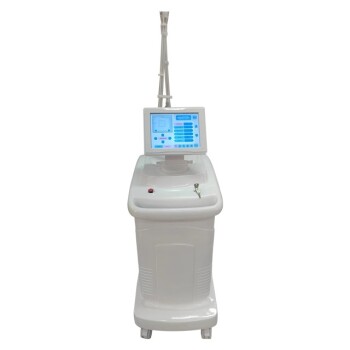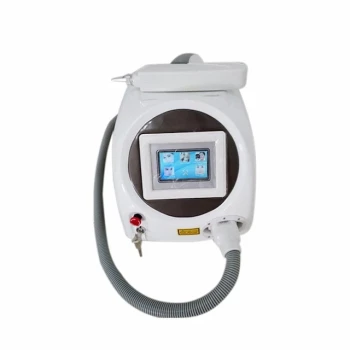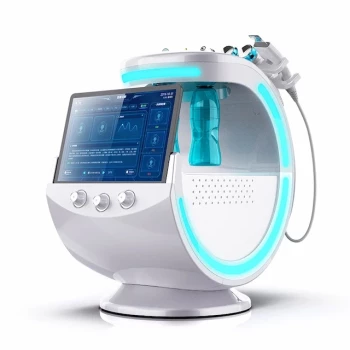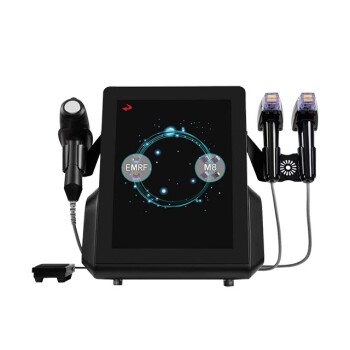In essence, a CO2 laser is a powerful skin resurfacing tool. It works by using a high-energy beam of light to precisely remove the outer, damaged layers of your skin. This process treats conditions like deep wrinkles, scars, sun damage, and warts by revealing healthier skin underneath and stimulating the body’s natural healing process.
The true purpose of a CO2 laser treatment is not just to remove old skin, but to trigger a profound healing response. This controlled injury signals your body to produce new collagen, resulting in skin that is fundamentally smoother, firmer, and more even in tone.

How a CO2 Laser Reshapes Your Skin
To understand the results, you must first understand the process. The CO2 laser operates on two fundamental principles: vaporization and thermal stimulation.
The Principle of Ablative Resurfacing
A CO2 laser is an ablative laser, which means it works by removing tissue. The laser emits a wavelength of light that is intensely absorbed by water molecules within your skin cells.
This absorption instantly heats and vaporizes the targeted cells, removing a thin, precise layer of skin with each pass. This is what allows a skilled practitioner to smooth out the edges of a scar or erase a surface-level wrinkle.
Stimulating Deep Collagen Production
The real transformative power of the laser lies beneath the surface. The heat from the laser energy penetrates into the deeper layer of the skin, the dermis.
This controlled thermal effect creates a "wound-healing" signal without destroying the surrounding tissue. In response, your body floods the area with fibroblasts, which are the cells responsible for creating new collagen and elastin—the core building blocks of strong, supple skin.
The Final Result: New, Reorganized Skin
Over the weeks and months following the treatment, this new collagen production remodels the skin from the inside out. Disorganized scar tissue is replaced with a smoother structure, and the support network beneath wrinkles is rebuilt, making the skin firmer and more resilient.
What a CO2 Laser Can Address
Because it works on both the surface and the deeper layers of the skin, a CO2 laser is highly effective for a range of significant skin concerns.
Deep Wrinkles and Fine Lines
By removing the outer layers and stimulating new collagen, the laser effectively plumps the skin from beneath, softening even deep-set wrinkles and fine lines.
Significant Scarring
It is considered a gold standard for treating various scars, including those from acne or surgery. The laser vaporizes the raised, disorganized scar tissue and encourages the growth of smoother, healthier skin in its place.
Sun Damage and Pigmentation
The laser removes the outermost layers of skin where sun damage, age spots, and uneven pigmentation are most visible, revealing a more uniform complexion.
Understanding the Trade-offs
The power of a CO2 laser comes with significant considerations. True objectivity requires understanding both its benefits and its demands.
The Inevitable Downtime
Because the laser physically removes layers of skin, there is a mandatory recovery period. Your skin will be red, swollen, and will require meticulous care for several days to a few weeks. This is not a "lunchtime" procedure.
Potential for Side Effects
In the hands of an expert, the procedure is safe, but risks exist. These can include prolonged redness, infection if post-care is neglected, and in some cases, changes in skin pigmentation (either darkening or lightening).
The Practitioner is Paramount
The outcome of a CO2 laser treatment is exceptionally operator-dependent. The "minimal damage to surrounding structures" is only achieved by a board-certified dermatologist or plastic surgeon with deep experience in laser physics and skin anatomy.
Making the Right Choice for Your Goal
To determine if this treatment is appropriate for you, weigh its intensity against your specific objectives.
- If your primary focus is significant wrinkle reduction or deep scar revision: The CO2 laser is one of the most effective tools available, provided you can commit to the required downtime for recovery.
- If your primary focus is mild texture issues or light sun damage: The intensity and recovery period of a CO2 laser might be more than you need, and less aggressive options could be considered first.
- If your primary concern is safety and achieving the best possible outcome: Your most critical step is to choose a highly qualified and experienced physician who can properly assess your skin and execute the treatment.
Ultimately, understanding how a CO2 laser directs your body's own healing power is the key to deciding if this potent technology aligns with your goals.
Summary Table:
| Treatment Goal | How the CO2 Laser Works | Key Outcome |
|---|---|---|
| Wrinkle Reduction | Vaporizes outer skin, heats dermis to stimulate collagen | Smoother, firmer skin from within |
| Scar Revision | Removes disorganized scar tissue, promotes new growth | Significantly improved skin texture |
| Sun Damage Removal | Precisely ablates pigmented, damaged surface layers | More even skin tone and complexion |
Ready to transform your skin with professional-grade technology?
BELIS specializes in providing medical aesthetic clinics and premium beauty salons with advanced, reliable CO2 laser systems. Our equipment is engineered for precise control and optimal patient outcomes, empowering practitioners to deliver exceptional skin resurfacing results.
Let us help you enhance your service offerings and patient satisfaction. Contact our experts today to find the perfect laser solution for your practice.
Visual Guide

Related Products
- Fractional CO2 Laser Machine for Skin Treatment
- Fractional CO2 Laser Machine for Skin Treatment
- Pico Picosecond Laser Machine for Tattoo Removal Picosure Pico Laser
- Hydrofacial Machine with Facial Skin Analyzer and Skin Tester
- Q Switch Nd Yag Laser Machine Tattoo Removal Nd Yag Machine
People Also Ask
- What is a fractional CO2 laser machine used for? A Guide to Advanced Skin Resurfacing
- Is CO2 laser for all skin types? A Critical Guide to Skin Type Safety and Risks
- What are medical lasers used for? Precision Tools for Surgery and Skin Treatments
- How long after a CO2 laser will I see results on my face? A Timeline for Transformation
- Who is not suitable for CO2 laser? Key Risks for Darker Skin & Active Conditions



















